Welcome to our comprehensive guide to banana plant care! Growing healthy banana plants may seem daunting, but fret not! We have curated simple and easy-to-follow tips to ensure your banana plant flourishes. Nutrients are vital for optimal growth, so providing a balanced mix of potassium, phosphorus, and nitrogen is crucial.
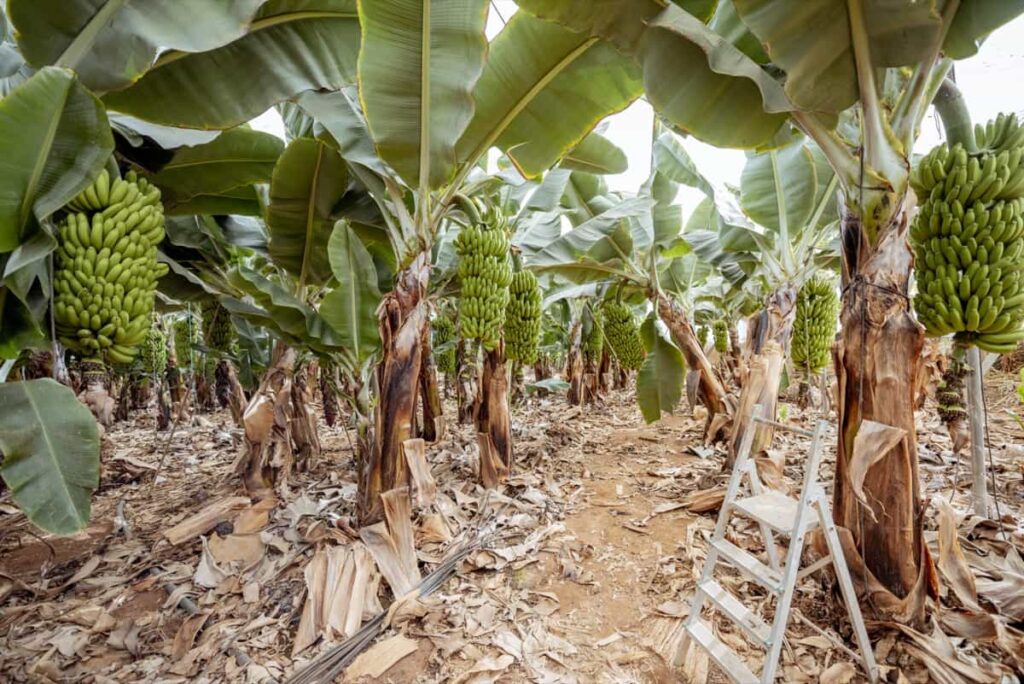
Fertilization is key; opt for organic choices like compost and well-rotted manure to enrich the soil. Protecting your precious plant from pests and diseases is a top priority. Employ natural remedies like neem oil or garlic spray, or use physical barriers to shield against invaders.
Understanding the Nutritional Needs of Banana Plants
The NPK ratio, representing the essential nutrients – Nitrogen (N), Phosphorus (P), and Potassium (K), plays a crucial role. Nitrogen stimulates robust foliage growth, which is necessary for healthy leaves and stems. Phosphorus aids root development, enabling better nutrient absorption and stronger root systems. Potassium promotes plant health, enhancing fruit production and bolstering resistance to stress and diseases.
The recommended NPK ratio for banana plants for optimal growth is 2:1:6, indicating a higher potassium content relative to nitrogen and phosphorus. This balanced blend ensures vigorous plant growth and bountiful yields. Ensure adequate soil enrichment using organic fertilizers or compost containing these essential elements. With the right NPK ratio and nutrients, your banana plants will flourish, delivering sweet, healthy fruits year after year.
Essential Nutrients for Healthy Banana Plant Growth
In banana plant growth, essential nutrients play a crucial role, and one effective way to enhance nutrient uptake is through biofertilizers. When applied to the soil or seeds, these preparations contain beneficial microorganisms that improve nutrient availability. Nitrogen-fixing microorganisms like Rhizobium, Mesorhizobium, and Pseudomonas positively impact plant growth, nodulation, and yield in crops like groundnut and chickpea.
Phosphate-solubilizing microorganisms (PSM) are also valuable as they reduce the need for expensive phosphatic fertilizers and enhance phosphate availability sustainably. PSMs, such as Pseudomonas tolaasii and Trichoderma asperellum, have positively affected maize and cucumber growth and yield.
Chemical fertilizers are another essential aspect of banana plant nutrition. Banana need large amounts of nitrogen and potassium, followed by phosphorus, calcium, and magnesium. Nitrogen promotes vegetative growth, while potassium is crucial for fruit development, quality, and stress resistance. Phosphorus stimulates root growth but must be applied carefully to avoid negative fruit size and weight effects.
In case you missed it: Optimizing Banana Orchard Management: A Month-by-Month Maintenance Guide for Maximum Yield

Choosing the Right Fertilizer for Banana Plants
Chemical fertilizers are crucial to banana plant nutrition due to their high nutrient requirements. Nitrogen and potassium are the primary nutrients needed, followed by phosphorus, calcium, and magnesium. Nitrogen is essential for vegetative growth, while potassium is vital for fruit development and quality.
Adequate potassium supply enhances plant physiology and boosts resistance to stress. The phosphorus requirement for bananas is relatively low compared to nitrogen and potassium. A balanced application is crucial when using chemical fertilizers to avoid excess phosphorus, which can negatively impact fruit size and weight.
Proper Fertilization Techniques for Banana Plants
- Soil Testing: Conduct regular soil tests to determine the specific nutrient requirements of your banana plants. This helps tailor the fertilizer application to the plant’s needs, avoiding over-fertilization.
- Controlled-Release Fertilizers: These specialized fertilizers gradually release nutrients over an extended period, ensuring a steady supply to the plants. This reduces the frequency of application and minimizes nutrient loss.
- Drip Irrigation: Implementing drip irrigation systems allows precise delivery of water and fertilizers directly to the plant root zones. This efficient technique conserves resources and maximizes nutrient absorption.
- Fertigation: Combining irrigation with fertilizer application through a drip system enables accurate nutrient dosing, improving plant nutrient utilization and reducing nutrient leaching.
- Foliar Feeding: Applying liquid fertilizers directly to the leaves enhances nutrient absorption and provides a quick boost during critical growth stages.
- Biofertilizers: Incorporating beneficial microorganisms into the soil through biofertilizers aids nutrient cycling and improves plant nutrient availability.
Organic Fertilizers for Sustainable Banana Plant Care
Organic fertilizers are a sustainable and eco-friendly approach to caring for banana plants, promoting soil health and biodiversity while reducing environmental impact. These natural alternatives include compost, vermicompost, green manure, biofertilizers, and seaweed extract. Compost, vermicompost, green manure, biofertilizers, and seaweed extract are all essential for improving soil structure, water retention, and nutrient availability in banana plants. These natural alternatives also enhance soil fertility, plant growth, and disease resistance, ultimately benefiting the overall health of banana plants.
Managing Soil pH for Optimal Banana Plant Health
Banana plants thrive in a tropical climate with temperatures ranging of 13ºC to 38ºC and relative humidity of 75-85%. The optimal growth temperature for bananas is around 27ºC, while temperatures above 38ºC and below 12ºC can harm the plant. High winds exceeding 80 km/h can also damage the crop.
The soil which have good drainage, adequate fertility, and moisture for optimal banana plant health. The preferred pH range for banana cultivation is between 6 and 7.5, indicating soil is neither too acidic nor too alkaline. The soil should be rich in organic material with high nitrogen content, sufficient phosphorus, and ample potash supply.
In case you missed it: Growing Banana Organically in Maharashtra: Cultivation Practices and Production Management
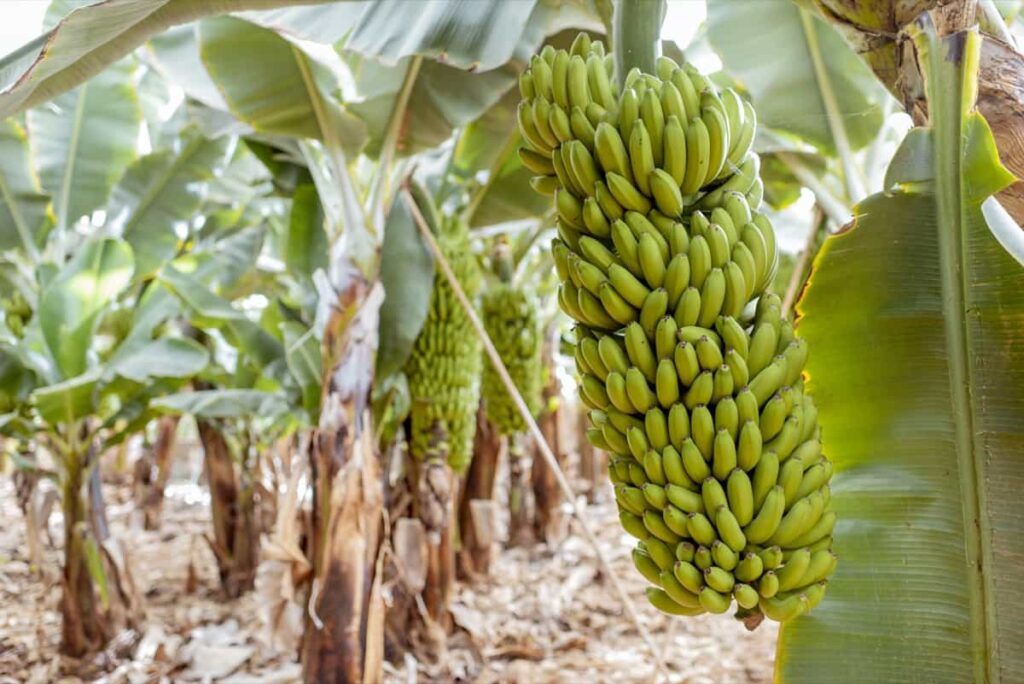
Watering Requirements and Techniques for Banana Plants
In the initial stages, water young plants regularly to establish strong root systems. As banana plants mature, water deeply and less frequently. Drip irrigation is an efficient technique that delivers water directly to the root zone, minimizing waste. Applying mulch around the plants retains soil moisture, reduces evaporation, and suppresses weed growth. Monitor soil moisture and adjust watering based on weather conditions and plant needs. Remember, overwatering can cause root rot and other issues, while underwatering can stunt growth and reduce fruit production.
Mulching to Conserve Moisture and Control Weeds in Banana Plantations
During planting, incorporate plenty of well-composted manure or compost into the soil. Add a quality controlled-release fertilizer to provide essential nutrients. Mulching should be applied generously around the plant while keeping it clear of the stem. For proper care, ensure adequate watering during hot and dry weather.
Regularly top up the mulch layer and remove dead leaves. Liquid feeds the plants and side-dress with well-composted manure during peak growing times. As the flowers develop into fruit, protect them from birds and bats using specialized covers or heavy-duty garden waste bags. Harvest bananas gradually as they ripen to avoid an excessively ripe bunch all at once.
Protecting Banana Plants from Common Pests and Diseases
Protecting banana plants from common pests and diseases is essential for a healthy and productive plantation. Common pests affecting banana plants include aphids, thrips, and weevils. These pests feed on plant tissues, causing damage to leaves and fruits, and can transmit harmful viruses. Implementing cultural practices like removing and destroying infected plant parts to combat these pests can help reduce their spread. Additionally, insecticidal soaps or neem oil sprays can effectively control these pests without harming beneficial insects.
As for diseases, the most notable one is Panama disease or Fusarium wilt, caused by the Fusarium fungus. This devastating disease affects the vascular system, leading to wilting and death of the plant. To prevent its spread, using disease-resistant banana varieties and practicing proper hygiene on the plantation is crucial. Like Sigatoka, leaf spot diseases caused by fungi can also affect banana plants. Regularly inspecting plants for symptoms and applying fungicides when necessary can help manage these diseases.
Identifying and Treating Pest Infestations in Banana Plants
- Common Pests: Pests like banana aphids, thrips, mites, and nematodes. Aphids suck plant sap, causing wilting, while thrips and mites damage leaves. Nematodes attack roots, affecting nutrient absorption.
- Symptoms: Look for stunted growth, yellowing leaves, distorted foliage, and drooping stems as signs of pest infestation.
- Natural Predators: Encourage beneficial insects like ladybugs, lacewings, and parasitic wasps to control pests naturally.
- Organic Pesticides: Neem oil, garlic spray, and insecticidal soaps are effective organic options to control pests without harming beneficial insects.
In case you missed it: Red Banana Farming in India: How to Start, Cultivation Practices, and Panting to Harvesting Guide
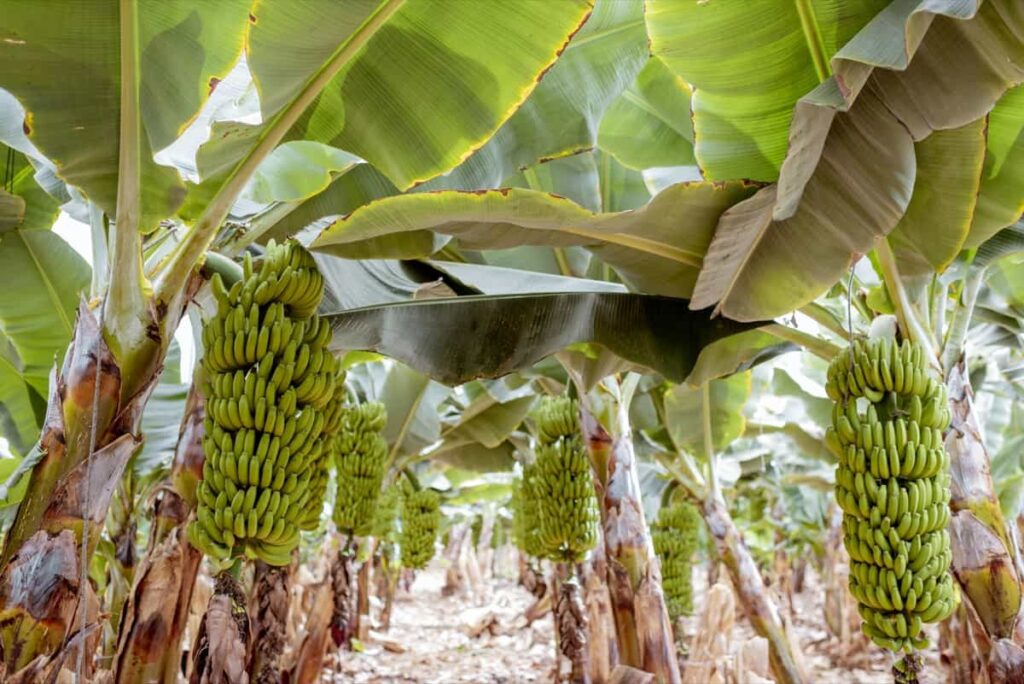
Preventing and Managing Common Diseases in Banana Plants
- The fungus Fusarium oxysporum is what causes Fusarium wilt, a soil-borne illness. Planting disease-resistant banana varieties and practicing crop rotation can help prevent its spread.
- Panama disease is the most destructive strain of this terrible disease; Fusarium oxysporum f. sp. cubense is Tropical Race 4. Using disease-free planting material and implementing strict biosecurity measures can help manage its spread.
- Mycosphaerella fijiensis is the fungus that causes Sigatoka leaf spot, a disease that affects banana leaves and lowers fruit yield. Regularly inspecting and promptly removing infected leaves and applying appropriate fungicides can help manage the disease.
Integrated Pest Management Strategies for Sustainable Banana Plant Care
Banana plants, scientifically known as Musa species and cultivars, are perennial plants that grow from large rhizomes. While they can reach towering heights of 5+ meters, some home and garden varieties are more manageable at 2-4 meters. These plants boast large, lush green leaves, measuring up to 2 meters in length and 50+ centimeters in width, with prominent veins and mid-ribs.
Banana plants thrive in tropical, sub-tropical, warm temperate, and certain warm micro-climates within cool temperate regions. They prefer deep, rich soil with reliable moisture and full-sun exposure, protected from harsh winds. Regarding nutrients, bananas require regular feeding using controlled-release fertilizers and well-composted manures. Adequate watering is essential, but they cannot tolerate waterlogged conditions.
Additionally, it’s crucial to protect the developing fruit from pests by using covers or bags. These attractive and versatile plants can be a delightful addition to home gardens, providing a tropical ambiance. In suitable climates, they produce delicious fruits high in vitamins and minerals. Cold climate varieties have been selected to grow in regions beyond traditional banana zones.
To successfully grow banana plants, prepare the soil with ample compost and fertilizer at planting time and apply controlled-release fertilizers. Regular watering, mulching, and pruning of excess suckers are necessary for healthy growth. However, growers should remain vigilant against two significant diseases: banana bunchy top virus (BBTV) and Panama disease tropical race 4 (PDTR4).
Pruning and Trimming Techniques for Healthy Banana Plants
- Remove Dead Leaves: Regularly trim off yellowing or dead leaves from the plant. This improves air circulation and prevents the accumulation of pests and diseases.
- Remove Suckers: Banana plants produce suckers or offshoots around the base. Remove excess suckers to allow the main plant to focus its energy on fruiting. Leave only a few strong and healthy suckers for future growth.
- Cut Inflorescence After Harvest: Trim the inflorescence (flower stalk) to ground level once the fruit bunch is harvested. This promotes new suckers and allows the plant to channel nutrients for the next bunch.
- Trim Pests or Disease-Affected Parts: If any part of the plant has pests or diseases, trim them immediately to stop their spread.
In case you missed it: The Ultimate Month-by-Month Guide to Custard Apple Orchard Management
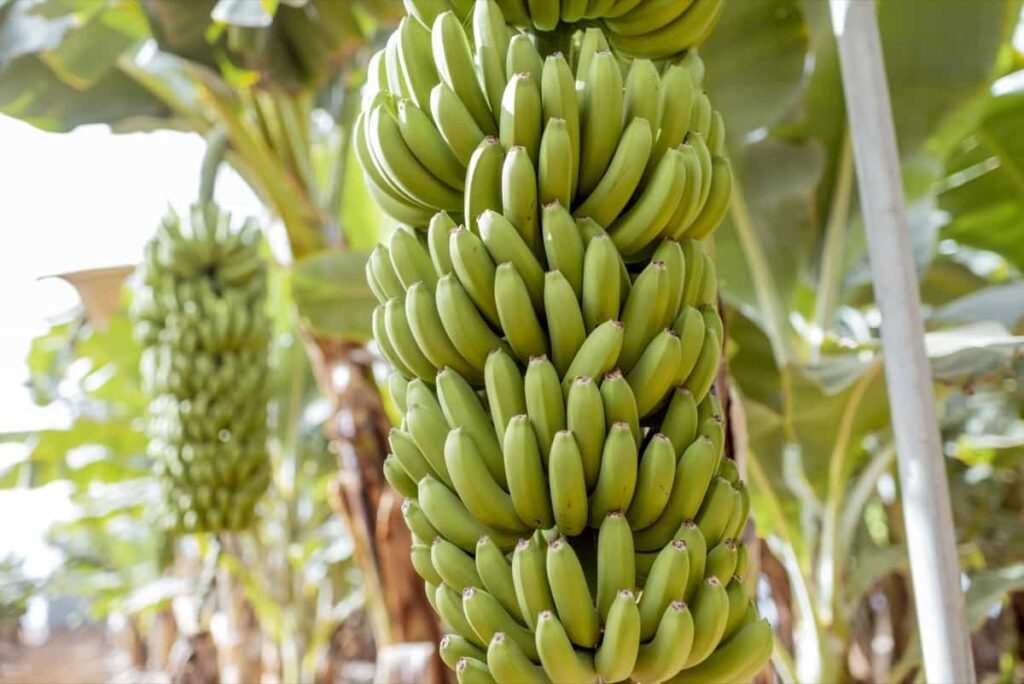
Protecting Banana Plants from Extreme Weather Conditions
- Frost Protection: In cooler areas, cover banana plants with frost blankets or burlap sacks during cold nights to shield them from frost damage.
- Wind Protection: High winds can damage banana leaves and hinder plant growth. Create windbreaks using fences and walls, or plant wind-resistant vegetation around the plantation.
- Sun Protection: Extreme heat can cause sun scorching in banana plants. Planting them in a location with partial shade or providing shade structures can help protect them from intense sunlight.
- Rain Protection: Excessive rainfall can lead to waterlogging, harming banana plants. Ensure proper drainage and avoid planting in low-lying areas to prevent water accumulation.
- Extreme Heat Protection: During heatwaves, increase irrigation frequency to keep the soil moist and maintain optimal plant hydration.
- Hail Protection: In hail-prone regions, consider installing hail nets or covers to shield banana plants from damage.
Harvesting and Storing Bananas: Best Practices for Quality Maintenance
Bananas should be harvested when the fruit reaches the desired maturity stage, usually when fully developed and firm but still green. Avoid harvesting too early or too late to ensure optimal taste and texture. Harvesting involves cutting the bunch with a sharp knife, leaving a portion of the stem attached to the fruit. This prevents damage to the bananas and reduces the risk of fungal infection.
After harvesting, bananas should be handled with care to avoid bruising. Store in cool, dry, well-ventilated area away from direct sunlight. The optimal storage temperature is around 13-15°C (55-59°F) with a relative humidity of 85-90%. To extend shelf life, consider using ethylene absorbent pads in storage containers. This reduces ripening and delays the onset of senescence. Regularly inspect stored bananas for signs of ripening or decay and remove any damaged fruits to prevent the spread of spoilage.
In case you missed it: Optimizing Sweet Orange Orchard Management: A Month-By-Month Operation Guide for Maximum Yield
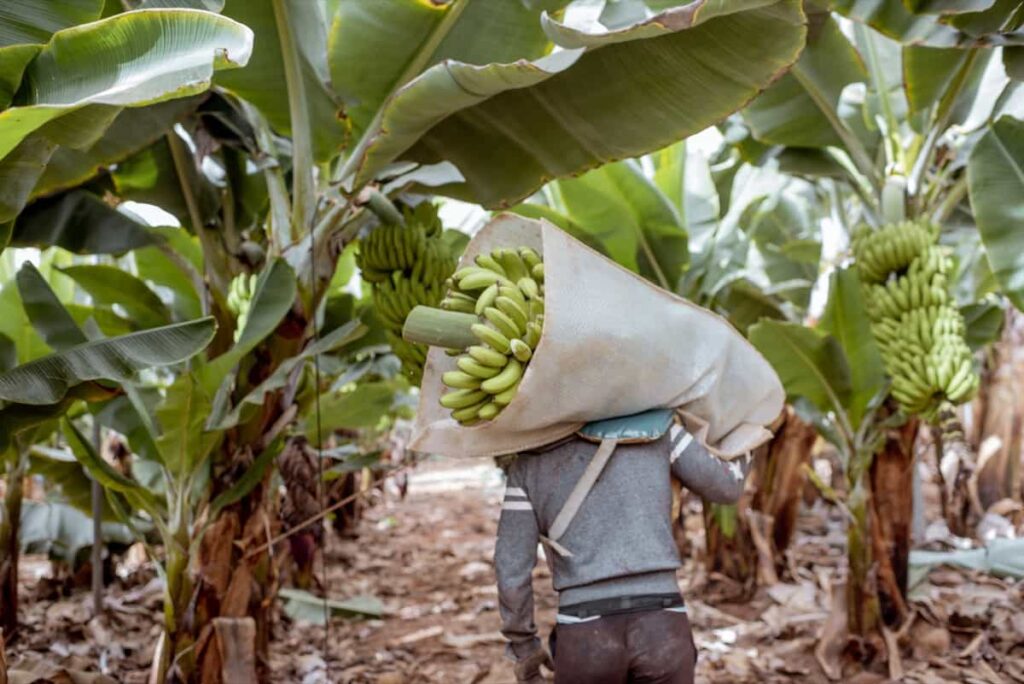
Conclusion
Proper care, including nutrient management, balanced fertilization, and effective pest and disease protection, is vital for healthy banana plant growth, optimal fruit production, and overall success in banana cultivation.
- How to Raise Pigs in Your Own Backyard: A Comprehensive Guide
- Budget Friendly Sheep Shed Ideas: Cheap and Low-Cost Tips
- How Much Do Cattle Farmers Make: Revenue Streams in Cattle Farming
- Management Pests and Diseases in Your Cotton Field
- Sheep Farming Business Plan for Beginners
- Aquaponic Farming at Home: A Step-By-Step Guide
- Profitable Village Farming Business Ideas in 2024
- High-Yield Aquaculture: Fast-Growing Fish for Farming
- Effective Fish Pond Construction Techniques for Beginners
- Irrigation and Water Management in Pineapple Farming
- Blossom to Harvest: Mastering Flowering and Pollination in Papaya Farming
- Pig Fattening Essentials: From Selection to Sale for Beginners
- Raising Wagyu Cattle: A Complete Guide for Premium Beef Production
- Soil Types and Their Water Holding Capacity
- Optimizing Irrigation Schedules for Coconut Groves for Enhanced Yield
- Espresso Your Garden: Coffee Grounds for Healthier Acid-Loving Plants
- The Best Soil Mix for Snake Plants: How to Mix Your Own Snake Plant Soil
- Green Thumb Success: Expert Tips for Cultivating Greenhouse Beans All Year Round
- Bloom All Year Round: The Ultimate Guide to Indoor Hyacinth Care
- Eco-Friendly Gardening: How to Make Liquid Fertilizer from Kitchen Waste
- Ultimate Guide to Grow Anise in Pots: Explore Seed Propagation to Harvesting
- Guide to Raising Chester White Pigs: Discover Breed Facts to Growth Management
- Mastering the Elegance: The Ultimate Guide to Weeping Cherry Tree Care, Planting, and Maintenance
- Ultimate Guide to Planting Garlic in Grow Bags: Growing Strategies for Beginners
- How to Fix Spider Plant Leaf-Related Problems: Natural and Organic Remedies
- 10 Reasons Why Your Tulsi Plant is Shedding Leaves: Home Remedies and Solutions
- Optimizing Growth and Yield: The Advantages of Palm Bunch Ash Fertilizer
- Utilizing Neem Oil Extract as a Natural Pesticide for Hydrangea
- From Soil to Harvest: Various Ways in Which Farmers Can Use AI Tools
- Steps to Encourage and Induce Citrus Flowers: A Comprehensive Guide
- How to Fix Snake Plant Leaf-Related Issues: Natural and Organic Remedies
- Transform Your Garden into a Fragrant Oasis with Raat Ki Rani (Night Blooming Jasmine)
- Discover the Ideal Chicken Breeds for Philippine Farms
- How to Create a Poultry Egg Farm Business Plan for Profits
- Grow Lemon Cucumbers Like a Pro: Insider Techniques for Bountiful Yields
- Ultimate Guide to Caring for Your Pink Princess Philodendron: Tips for Thriving Variegation
